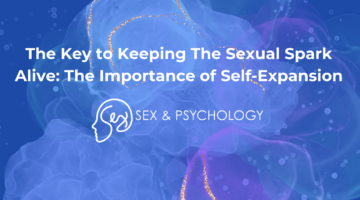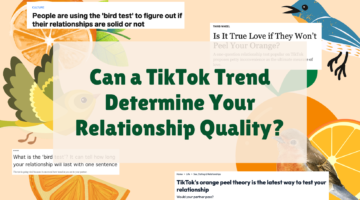The Dark Side of Sexual Attraction: People are Often Drawn to Antisocial Personalities
March 31, 2021 by Justin Lehmiller
When I look at studies examining what people say they want in a romantic partner, people tend to report a lot of positive traits. For example, kindness, honesty, and dependability are reliably near the top of the list. In other words, we say we’re attracted to nice people—and people we hope will treat us well in return.
However, there’s an interesting paradox in the scientific literature on attraction. While people say they’re attracted to nice partners, they simultaneously report being attracted to individuals with “dark” personality traits.
In fact, there is a cluster of three personality traits—known as the Dark Triad—that have been shown to be related to heightened attraction across multiple studies. These traits are Machiavellianism, psychopathy, and narcissism. Although each one signifies something a little different, they’re all tied together by a tendency to engage in antisocial behaviors, such as being callous and manipulative.
On the surface, these traits don’t sound like things that would intuitively be sexually or romantically appealing. However, it turns out that they are often mistaken for attractive traits. For example, if you don’t know a narcissist very well, their overly inflated self-views and tendency to talk about themselves can potentially come across as being talkative and/or confident.
Likewise, narcissists and other social manipulators often make an effort to put on a pretty attractive veneer. For instance, they might invest more time and effort into their appearance, surround themselves with symbols of money and success, and make a greater effort to say the “right” things (even if they aren’t true) in order to appear desirable, or manipulate someone else into liking them.
Several studies have shown that people with these dark traits are often rated as being more attractive than people who are low on these traits.
In one study, a group of college women were asked to rate the attractiveness of profiles of men who varied in their levels of the Dark Triad traits [1]. The physical characteristics of the men were held constant—what varied was only whether they were high or low in these three personality characteristics.
The men who were high in Dark Triad traits were rated as being significantly more attractive than the men who were low on them—and it was a fairly sizeable difference (specifically, more than a full scale point). What was especially interesting about this study is that the researchers also asked participants to evaluate the men on their perceived levels of narcissism, Machiavellianism, and psychopathy—and the men who were high on these traits were indeed perceived as such. So the participants consciously recognized this fact, yet still rated them as more attractive.
In another study, which I previously summarized on the blog, people who fall in love fast, easily, and often (i.e., those high in the trait of emophilia) reported greater attraction to profiles of individuals who were high in Dark Triad traits than did people who were low on emophilia [2]. This suggests that people who believe in “love at first sight” seem to be more easily seduced by partners who have dark personalities, perhaps mistaking these dark traits for attractive features in their quest for love.
Yet another study, which focused on the genetics of antisocial personality traits, actually found that people with these traits seem to have a reproductive advantage over others [3]. Specifically, the genes that have been linked to antisocial traits were also correlated with the genes associated with reproducing earlier in life and having more children. In other words, having less care and concern for other people was associated with having more children.
Why is that? Psychopathy is linked to living a “fast life”—these individuals tend to take more risks and act more impulsively. One outcome of this is that they tend to start reproducing earlier in life and having more children over time.
So when you combine the fact that “dark” personalities are often seen as attractive (at least initially) with higher levels of risk-taking and impulsive behavior amongst the persons who have these traits, you end up with a situation in which those traits not only have the opportunity to survive, but thrive in the population.
The genes that predispose people to these traits therefore have the potential to get passed on in greater numbers over time. It’s an uncomfortable thought to be sure, but it’s really just evolution at work. Evolution is a tricky thing in that it doesn’t care about morality, justice, or political correctness. It operates independently of our social values. The traits that facilitate attraction and reproduction are the traits most likely to be passed on, regardless of whether we value those traits or not.
Want to learn more about Sex and Psychology? Click here for more from the blog or here to listen to the podcast. Follow Sex and Psychology on Facebook, Twitter (@JustinLehmiller), or Reddit to receive updates. You can also follow Dr. Lehmiller on YouTube and Instagram.
[1] Carter, G. L., Campbell, A. C., & Muncer, S. (2014). The dark triad personality: Attractiveness to women. Personality and Individual Differences, 56, 57-61.
[2] Lechuga, J., & Jones, D. N. Emophilia and other predictors of attraction to individuals with Dark Triad traits. Personality and Individual Differences, 168, 110318.
[3] Tielbeek, J. J., Barnes, J. C., Popma, A., Polderman, T. J., Lee, J. J., Perry, J. R., … & Boutwell, B. B. (2018). Exploring the genetic correlations of antisocial behaviour and life history traits. BJPsych open, 4(6), 467-470.
Image Source: 123RF/lightfieldstudios

Dr. Justin Lehmiller
Founder & Owner of Sex and PsychologyDr. Justin Lehmiller is a social psychologist and Research Fellow at The Kinsey Institute. He runs the Sex and Psychology blog and podcast and is author of the popular book Tell Me What You Want. Dr. Lehmiller is an award-winning educator, and a prolific researcher who has published more than 50 academic works.
Read full bio >


